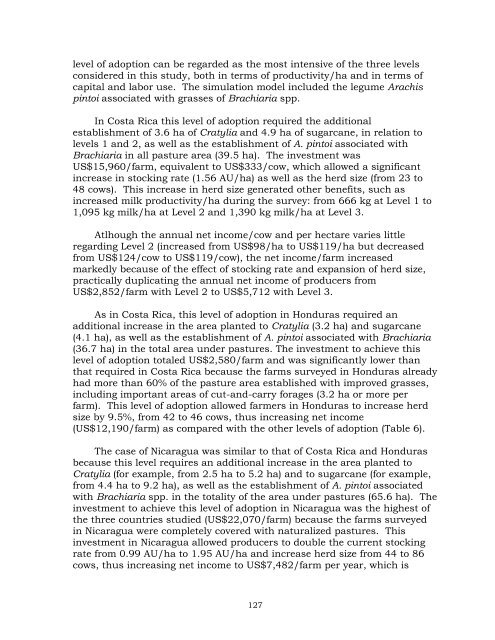Feeding Systems with Legumes to Intensify Dairy Farms - cgiar
Feeding Systems with Legumes to Intensify Dairy Farms - cgiar
Feeding Systems with Legumes to Intensify Dairy Farms - cgiar
You also want an ePaper? Increase the reach of your titles
YUMPU automatically turns print PDFs into web optimized ePapers that Google loves.
level of adoption can be regarded as the most intensive of the three levels<br />
considered in this study, both in terms of productivity/ha and in terms of<br />
capital and labor use. The simulation model included the legume Arachis<br />
pin<strong>to</strong>i associated <strong>with</strong> grasses of Brachiaria spp.<br />
In Costa Rica this level of adoption required the additional<br />
establishment of 3.6 ha of Cratylia and 4.9 ha of sugarcane, in relation <strong>to</strong><br />
levels 1 and 2, as well as the establishment of A. pin<strong>to</strong>i associated <strong>with</strong><br />
Brachiaria in all pasture area (39.5 ha). The investment was<br />
US$15,960/farm, equivalent <strong>to</strong> US$333/cow, which allowed a significant<br />
increase in s<strong>to</strong>cking rate (1.56 AU/ha) as well as the herd size (from 23 <strong>to</strong><br />
48 cows). This increase in herd size generated other benefits, such as<br />
increased milk productivity/ha during the survey: from 666 kg at Level 1 <strong>to</strong><br />
1,095 kg milk/ha at Level 2 and 1,390 kg milk/ha at Level 3.<br />
Atlhough the annual net income/cow and per hectare varies little<br />
regarding Level 2 (increased from US$98/ha <strong>to</strong> US$119/ha but decreased<br />
from US$124/cow <strong>to</strong> US$119/cow), the net income/farm increased<br />
markedly because of the effect of s<strong>to</strong>cking rate and expansion of herd size,<br />
practically duplicating the annual net income of producers from<br />
US$2,852/farm <strong>with</strong> Level 2 <strong>to</strong> US$5,712 <strong>with</strong> Level 3.<br />
As in Costa Rica, this level of adoption in Honduras required an<br />
additional increase in the area planted <strong>to</strong> Cratylia (3.2 ha) and sugarcane<br />
(4.1 ha), as well as the establishment of A. pin<strong>to</strong>i associated <strong>with</strong> Brachiaria<br />
(36.7 ha) in the <strong>to</strong>tal area under pastures. The investment <strong>to</strong> achieve this<br />
level of adoption <strong>to</strong>taled US$2,580/farm and was significantly lower than<br />
that required in Costa Rica because the farms surveyed in Honduras already<br />
had more than 60% of the pasture area established <strong>with</strong> improved grasses,<br />
including important areas of cut-and-carry forages (3.2 ha or more per<br />
farm). This level of adoption allowed farmers in Honduras <strong>to</strong> increase herd<br />
size by 9.5%, from 42 <strong>to</strong> 46 cows, thus increasing net income<br />
(US$12,190/farm) as compared <strong>with</strong> the other levels of adoption (Table 6).<br />
The case of Nicaragua was similar <strong>to</strong> that of Costa Rica and Honduras<br />
because this level requires an additional increase in the area planted <strong>to</strong><br />
Cratylia (for example, from 2.5 ha <strong>to</strong> 5.2 ha) and <strong>to</strong> sugarcane (for example,<br />
from 4.4 ha <strong>to</strong> 9.2 ha), as well as the establishment of A. pin<strong>to</strong>i associated<br />
<strong>with</strong> Brachiaria spp. in the <strong>to</strong>tality of the area under pastures (65.6 ha). The<br />
investment <strong>to</strong> achieve this level of adoption in Nicaragua was the highest of<br />
the three countries studied (US$22,070/farm) because the farms surveyed<br />
in Nicaragua were completely covered <strong>with</strong> naturalized pastures. This<br />
investment in Nicaragua allowed producers <strong>to</strong> double the current s<strong>to</strong>cking<br />
rate from 0.99 AU/ha <strong>to</strong> 1.95 AU/ha and increase herd size from 44 <strong>to</strong> 86<br />
cows, thus increasing net income <strong>to</strong> US$7,482/farm per year, which is<br />
127
















